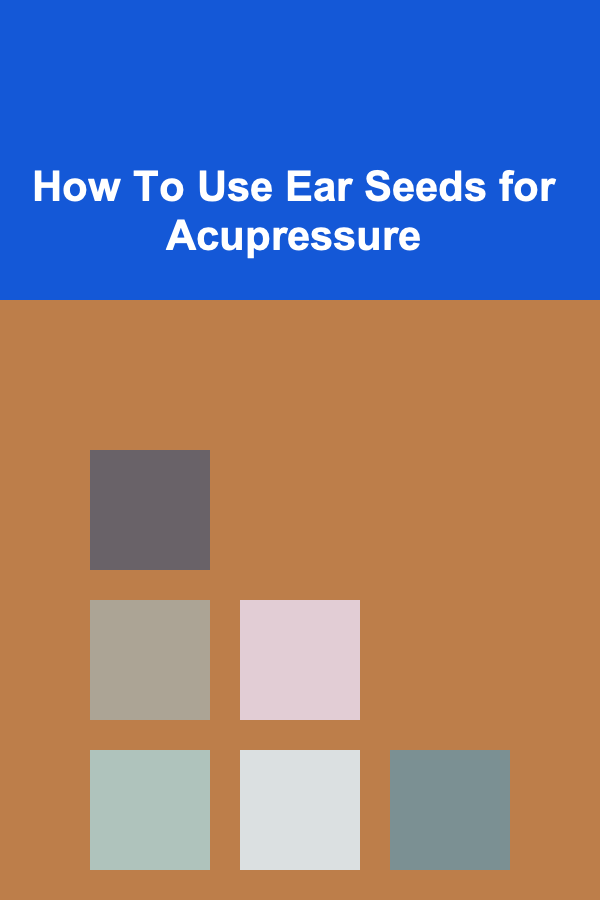
How To Use Ear Seeds for Acupressure
ebook include PDF & Audio bundle (Micro Guide)
$12.99$7.99
Limited Time Offer! Order within the next:

Ear seeds, also known as auricular therapy, are a popular method of acupressure used in traditional Chinese medicine (TCM) for various health and wellness benefits. This non-invasive therapy involves the application of small seeds (often from the Vaccaria plant) or tiny metal beads to specific points on the ear, which correspond to different organs and systems of the body. By stimulating these points, ear seeds can help balance the body's energy, promote healing, reduce pain, and alleviate stress. In this article, we will explore the history, benefits, techniques, and practical applications of ear seeds in acupressure.
The History and Theory Behind Ear Seeds
Origins of Auricular Therapy
Auricular therapy dates back thousands of years and is believed to have originated in ancient China. The concept is rooted in the belief that the ear is a microcosm of the entire body. The theory suggests that specific points on the ear correspond to different organs and systems within the body, and by applying pressure to these points, one can promote healing and improve overall health.
The first recorded use of ear acupuncture or acupressure was by the Chinese physician Wang Weiyi in the 1950s. He developed a system of mapping the ear's anatomy based on the idea that the ear's shape mirrored the body's structure. This system laid the groundwork for modern auricular therapy.
In the 1950s, Dr. Paul Nogier, a French neurologist, is credited with discovering the modern map of the ear, which categorizes points on the ear that correspond to specific body parts. His discoveries have been instrumental in popularizing auricular acupuncture and acupressure in Western medicine.
The Role of Ear Seeds in Auricular Therapy
Ear seeds are part of a form of acupressure that utilizes pressure, rather than needles, to stimulate the points on the ear. Acupressure is a technique that applies manual pressure to specific points on the body to restore balance, alleviate symptoms, and improve health. When ear seeds are placed on specific auricular points, they act as a continuous source of pressure on these points, making them a convenient and accessible option for individuals seeking relief from various ailments.
The Benefits of Using Ear Seeds for Acupressure
Ear seeds offer a wide range of benefits for physical, emotional, and mental health. Because they are non-invasive, simple to use, and can be applied at home, they have gained popularity as a safe and effective alternative to other forms of acupressure and acupuncture. Here are some of the key benefits of using ear seeds:
1. Pain Relief
Ear seeds are often used to alleviate various types of pain, including chronic pain, headaches, migraines, and musculoskeletal pain. The points on the ear that correspond to pain relief are carefully selected and stimulated using ear seeds, promoting the body's natural pain-relief mechanisms. Research has shown that auricular acupressure may help release endorphins, the body's natural painkillers, and reduce the perception of pain.
2. Stress and Anxiety Reduction
Ear seeds are also commonly used to help manage stress, anxiety, and other emotional health issues. The ear contains points that are linked to the autonomic nervous system, which controls stress responses. Stimulating these points can help regulate the body's stress response, reduce cortisol levels, and promote relaxation. Regular use of ear seeds for stress relief can lead to better emotional regulation and an overall sense of calm.
3. Improved Sleep Quality
Many people use ear seeds to improve their sleep quality and treat insomnia. Certain auricular points are associated with the regulation of sleep patterns, and by applying ear seeds to these points, individuals can encourage relaxation, reduce anxiety, and promote better sleep. Studies have found that auricular acupressure can significantly improve the quality and duration of sleep, making it a popular choice for those with sleep disturbances.
4. Support for Digestion and Weight Loss
Auricular therapy is also believed to have positive effects on digestion and weight management. Specific ear points are connected to the digestive system, and stimulating these areas may help alleviate symptoms of indigestion, bloating, and constipation. Additionally, ear seeds can be used to help curb cravings and support weight loss efforts by regulating appetite and promoting healthier eating habits.
5. Emotional Well-Being
Ear seeds can play a significant role in improving emotional well-being by addressing underlying imbalances in the body's energy. Through the stimulation of specific auricular points, ear seeds can help alleviate symptoms of depression, promote emotional stability, and improve overall mood. The practice is often used in conjunction with other therapeutic modalities to create a holistic approach to mental health.
How to Use Ear Seeds for Acupressure
1. Understanding the Ear Map
Before using ear seeds, it is essential to understand the basic ear map, which corresponds to specific areas of the body. The ear is divided into different regions, each associated with a particular system or organ. For instance:
- The tragus and anti-tragus areas are commonly used for pain relief, stress reduction, and sleep improvement.
- The helix and lobe are linked to digestive health, weight management, and emotional balance.
- The concha is associated with the brain and nervous system, helping with anxiety and relaxation.
By understanding where the points are located and which part of the body they influence, you can apply ear seeds to the appropriate areas for targeted therapeutic benefits.
2. Applying Ear Seeds
The process of applying ear seeds is simple and can be done by yourself or with the help of a trained practitioner. Here are the steps for applying ear seeds at home:
Materials Needed:
- Ear seeds (vaccaria seeds, metal beads, or adhesive ear seeds)
- Alcohol swab or cotton ball (to clean the ear)
- A pair of tweezers
- A mirror for accuracy
Step-by-Step Instructions:
- Clean the Ear: Begin by cleaning your ears and the surrounding area with an alcohol swab or cotton ball to remove dirt and oils. This will ensure that the adhesive on the ear seeds sticks properly and remains in place for an extended period.
- Locate the Points: Use an ear map or consult with a trained professional to identify the specific auricular points you wish to stimulate. Each point on the ear is associated with a different organ or system, so it's important to place the ear seeds on the correct areas based on your health needs.
- Place the Ear Seeds: Using a pair of tweezers, gently place the ear seeds on the selected points. The seeds are typically placed on the ear's surface, where they will apply light pressure to the corresponding acupressure points. If you are using adhesive ear seeds, they should stay in place for several days.
- Press and Stimulate: After placing the ear seeds, gently press on them using your fingers. You can also massage the area around the ear to further stimulate the acupressure points. The goal is to create a subtle but continuous pressure that helps activate the points and promotes healing.
- Maintain the Ear Seeds: Ear seeds typically stay in place for 3 to 5 days. During this time, you can gently press on the seeds to continue stimulating the points, or you can leave them undisturbed for passive benefits.
- Remove the Seeds: After a few days, gently remove the ear seeds using tweezers. Clean the area again with an alcohol swab to ensure the skin is free of any residue.
3. Frequency of Use
The frequency of using ear seeds for acupressure depends on your specific health goals and needs. Some people use ear seeds daily, while others may use them intermittently as a way to address particular symptoms, such as anxiety or pain. If you are using ear seeds for sleep or stress, you may want to apply them in the evening or just before bedtime for maximum relaxation.
4. Combining with Other Therapies
Ear seeds are often used as part of a broader wellness routine. They can be combined with other forms of acupressure, acupuncture, or holistic therapies for enhanced benefits. For example, using ear seeds alongside mindfulness meditation or yoga can amplify their effectiveness in promoting relaxation and reducing stress.
Who Can Benefit from Ear Seeds?
Ear seeds can be a valuable tool for individuals of all ages who are seeking to improve their health and well-being. Some of the individuals who may benefit from ear seeds include:
- People with chronic pain: Those dealing with conditions like arthritis, back pain, or migraines may find relief through ear seed therapy.
- Individuals with anxiety or stress: People who struggle with anxiety, stress, or emotional imbalances may experience significant improvement through the use of ear seeds.
- Those with sleep disorders: Individuals who suffer from insomnia or other sleep disturbances can benefit from ear seeds that target sleep-regulating points.
- People looking to support digestion or weight loss: Those aiming to improve their digestion or manage their weight may find ear seed therapy helpful as part of a holistic approach to health.
Safety and Considerations
Ear seed therapy is generally considered safe, but there are a few considerations to keep in mind:
- Consult a Professional: If you are new to ear seeds or auricular therapy, it may be beneficial to consult with a trained practitioner who can guide you in selecting the appropriate points and techniques.
- Avoid Sensitive Areas: If you have any open wounds, infections, or injuries on your ears, avoid applying ear seeds to those areas to prevent irritation or infection.
- Allergic Reactions: Although rare, some individuals may have allergic reactions to the adhesive or materials used in ear seeds. If you experience irritation or discomfort, remove the ear seeds and consult with a healthcare professional.
Conclusion
Ear seeds for acupressure offer a powerful and accessible method for improving health, managing stress, and addressing a wide range of physical and emotional issues. By applying gentle pressure to specific points on the ear, individuals can experience relief from pain, anxiety, sleep disturbances, and more. Whether used alone or as part of a broader wellness regimen, ear seeds are a safe and effective therapy that can promote healing and balance within the body. With their non-invasive nature and ease of use, ear seeds are an excellent tool for anyone seeking a holistic approach to health and well-being.

Build Your Brand: How to Stand Out in a Fast-Paced Retail Environment as a Retail Sales Associate
Read More
How to Braise Meats for Tenderness
Read More
How to Build an Emergency Fund Without Sacrificing Other Goals
Read More
How to Understand the Role of Subplots
Read More
How To Build a Strong Pre-Marital Foundation
Read MoreHow to Integrate Habit Tracking into Your Monthly Planner
Read MoreOther Products

Build Your Brand: How to Stand Out in a Fast-Paced Retail Environment as a Retail Sales Associate
Read More
How to Braise Meats for Tenderness
Read More
How to Build an Emergency Fund Without Sacrificing Other Goals
Read More
How to Understand the Role of Subplots
Read More